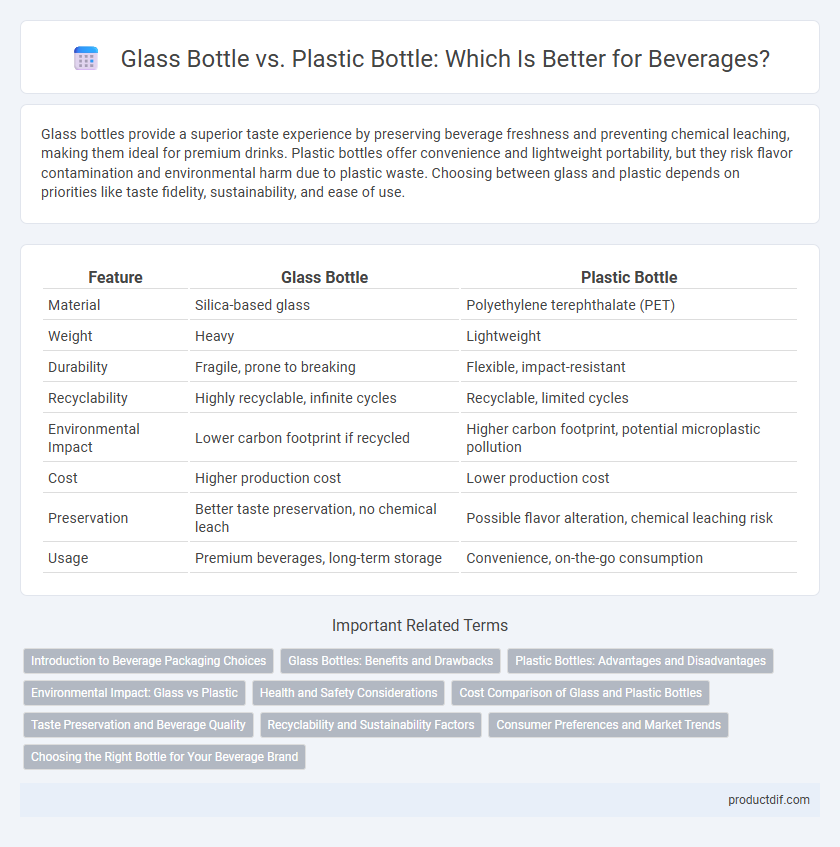Glass bottles provide a superior taste experience by preserving beverage freshness and preventing chemical leaching, making them ideal for premium drinks. Plastic bottles offer convenience and lightweight portability, but they risk flavor contamination and environmental harm due to plastic waste. Choosing between glass and plastic depends on priorities like taste fidelity, sustainability, and ease of use.
Table of Comparison
| Feature | Glass Bottle | Plastic Bottle |
|---|---|---|
| Material | Silica-based glass | Polyethylene terephthalate (PET) |
| Weight | Heavy | Lightweight |
| Durability | Fragile, prone to breaking | Flexible, impact-resistant |
| Recyclability | Highly recyclable, infinite cycles | Recyclable, limited cycles |
| Environmental Impact | Lower carbon footprint if recycled | Higher carbon footprint, potential microplastic pollution |
| Cost | Higher production cost | Lower production cost |
| Preservation | Better taste preservation, no chemical leach | Possible flavor alteration, chemical leaching risk |
| Usage | Premium beverages, long-term storage | Convenience, on-the-go consumption |
Introduction to Beverage Packaging Choices
Glass bottles and plastic bottles serve as primary packaging materials in the beverage industry, each offering unique benefits and challenges. Glass bottles provide superior product protection and preserve flavor integrity due to their impermeability and inert nature, making them ideal for premium beverages. Plastic bottles, commonly made from PET, offer lightweight convenience, cost-effectiveness, and recyclability, enhancing portability and reducing transportation emissions.
Glass Bottles: Benefits and Drawbacks
Glass bottles offer superior taste preservation and are fully recyclable, reducing environmental impact compared to plastic containers. They provide a non-toxic, BPA-free option that does not leach chemicals into beverages, ensuring product purity and consumer safety. However, glass bottles are heavier, more fragile, and costlier to transport and manufacture, which can increase overall product expenses.
Plastic Bottles: Advantages and Disadvantages
Plastic bottles offer lightweight convenience and enhanced durability, reducing transportation costs and minimizing breakage compared to glass bottles. They provide better resistance to shattering, making them ideal for outdoor and on-the-go beverage consumption, but may contribute to environmental pollution due to lower recycling rates and longer degradation times. The potential leaching of chemicals like BPA in some plastic bottles raises health concerns, prompting increased demand for BPA-free and recyclable alternatives in the beverage industry.
Environmental Impact: Glass vs Plastic
Glass bottles have a significantly lower environmental impact compared to plastic bottles due to their recyclability and inert composition, which prevents chemical leaching into ecosystems. Plastic bottles contribute to pollution through slow degradation, release of harmful microplastics, and dependence on fossil fuels for production. Choosing glass reduces landfill waste and supports sustainable resource use by enabling repeated recycling without loss of material quality.
Health and Safety Considerations
Glass bottles are generally considered safer for health as they are non-porous, impermeable, and free from harmful chemicals like BPA that can leach from plastic bottles. Plastic bottles pose risks of chemical migration, especially when exposed to heat or sunlight, potentially contaminating beverages with endocrine disruptors. From a safety perspective, glass is more inert and preserves beverage integrity, but it is heavier and more prone to breakage, which can lead to physical injury.
Cost Comparison of Glass and Plastic Bottles
Glass bottles generally incur higher production and transportation costs due to their weight and fragility, leading to increased shipping expenses. Plastic bottles, made from materials like PET, offer a more cost-effective alternative with lower manufacturing and logistics costs, making them popular in mass beverage distribution. While glass bottles can be more expensive upfront, their reusability and recyclability can offset costs over time in certain markets.
Taste Preservation and Beverage Quality
Glass bottles provide superior taste preservation by preventing flavor contamination and maintaining the beverage's original freshness due to their impermeable and non-reactive properties. Plastic bottles often allow micro-oxygen permeation, which can alter beverage quality and lead to off-flavors over time. For premium beverages, glass packaging ensures optimal taste integrity and longer shelf life compared to plastic alternatives.
Recyclability and Sustainability Factors
Glass bottles offer superior recyclability as they can be recycled infinitely without quality loss, reducing resource consumption and landfill impact. Plastic bottles, while lightweight and convenient, often face downcycling and lower recycling rates, leading to increased environmental pollution and resource depletion. Sustainability assessments favor glass packaging for its closed-loop recycling and lower carbon footprint when reused, despite higher transport emissions due to weight.
Consumer Preferences and Market Trends
Consumer preferences in the beverage industry increasingly favor glass bottles due to their perceived environmental benefits, premium appearance, and superior taste preservation compared to plastic bottles. Market trends reveal a growing demand for sustainable packaging, with glass bottles experiencing higher growth rates, especially among eco-conscious millennials and Gen Z consumers. Brands leveraging glass packaging capitalize on these shifts, enhancing product positioning in premium and organic beverage segments.
Choosing the Right Bottle for Your Beverage Brand
Selecting the ideal bottle for your beverage brand involves evaluating factors such as product type, target audience, and sustainability goals. Glass bottles offer superior flavor preservation and premium appeal but come with higher production and transportation costs. Plastic bottles provide lightweight convenience and cost-effectiveness, making them suitable for on-the-go consumers, yet they raise environmental concerns due to limited recyclability.
Glass Bottle vs Plastic Bottle Infographic

 productdif.com
productdif.com